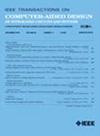Circuit Partitioning and Transmission Cost Optimization in Distributed Quantum Circuits
IF 2.9
3区 计算机科学
Q2 COMPUTER SCIENCE, HARDWARE & ARCHITECTURE
IEEE Transactions on Computer-Aided Design of Integrated Circuits and Systems
Pub Date : 2025-03-04
DOI:10.1109/TCAD.2025.3547812
引用次数: 0
Abstract
Given the limitations on the number of qubits in current noisy intermediate-scale quantum (NISQ) devices, the implementation of large-scale quantum algorithms on such devices is challenging, prompting research into distributed quantum computing. This article focuses on the issue of excessive communication complexity in distributed quantum computing based on the quantum circuit model. To reduce the number of quantum state transmissions, i.e., the transmission cost, in distributed quantum circuits, a circuit partitioning method based on the quadratic unconstrained binary optimization (QUBO) model is proposed, coupled with the lookahead method for transmission cost optimization. Initially, the problem of distributed quantum circuit partitioning is transformed into a graph minimum cut problem. The QUBO model, which can be accelerated by quantum annealing algorithms, is introduced to minimize the number of quantum gates between quantum processing units (QPUs) and the transmission cost. Subsequently, the dynamic lookahead strategy for the selection of transmission qubits is proposed to optimize the transmission cost in distributed quantum circuits. Finally, through numerical simulations, the impact of different circuit partitioning indicators on the transmission cost is explored, and the proposed method is evaluated on benchmark circuits. Experimental results demonstrate that the proposed circuit partitioning method has a shorter runtime compared with current circuit partitioning methods. Additionally, the transmission cost optimized by the proposed method is significantly lower than that of current transmission cost optimization methods, achieving noticeable improvements across different numbers of partitions.分布式量子电路的电路划分与传输成本优化
鉴于当前噪声中尺度量子(NISQ)设备中量子比特数量的限制,在此类设备上实现大规模量子算法是具有挑战性的,这促使了对分布式量子计算的研究。本文主要研究基于量子电路模型的分布式量子计算中通信复杂度过高的问题。为了减少分布式量子电路中量子态传输的数量即传输成本,提出了一种基于二次无约束二进制优化(QUBO)模型的电路划分方法,并结合传输成本优化的前瞻性方法。首先,将分布式量子电路划分问题转化为图最小割问题。为了最大限度地减少量子处理单元(qpu)之间的量子门数量和传输成本,引入了量子退火算法加速的QUBO模型。随后,为了优化分布式量子电路中的传输成本,提出了传输量子比特的动态前瞻选择策略。最后,通过数值模拟,探讨了不同电路划分指标对传输成本的影响,并在基准电路上对所提方法进行了评估。实验结果表明,与现有的电路划分方法相比,所提出的电路划分方法具有更短的运行时间。此外,该方法优化的传输成本明显低于现有的传输成本优化方法,在不同分区数量上都有明显的改进。
本文章由计算机程序翻译,如有差异,请以英文原文为准。
求助全文
约1分钟内获得全文
求助全文
来源期刊
CiteScore
5.60
自引率
13.80%
发文量
500
审稿时长
7 months
期刊介绍:
The purpose of this Transactions is to publish papers of interest to individuals in the area of computer-aided design of integrated circuits and systems composed of analog, digital, mixed-signal, optical, or microwave components. The aids include methods, models, algorithms, and man-machine interfaces for system-level, physical and logical design including: planning, synthesis, partitioning, modeling, simulation, layout, verification, testing, hardware-software co-design and documentation of integrated circuit and system designs of all complexities. Design tools and techniques for evaluating and designing integrated circuits and systems for metrics such as performance, power, reliability, testability, and security are a focus.

 求助内容:
求助内容: 应助结果提醒方式:
应助结果提醒方式:


